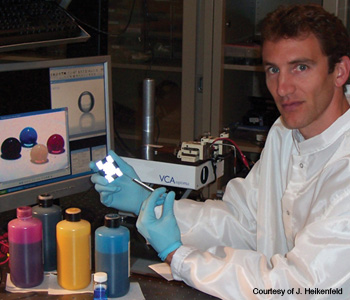Feature
Recent Progress in Arrayed Electrowetting Optics
Electrowetting devices can now be formed in arrays covering thousands of square centimeters of glass. New research is pointing the way toward exciting applications for laser radar, 3D displays, adaptive camouflage, electronic paper, retroreflector communication and lab-on-a-chip.
 Jason Heikenfeld, one of the authors, holds an electrowetting retroreflector prototype.
Jason Heikenfeld, one of the authors, holds an electrowetting retroreflector prototype.
Electrowetting—a technique for manipulating small amounts of liquid on surfaces—has considerable roots in optics. Nearly a century after Lippmann’s groundbreaking work in electrocapillarity, Beni and Hackwood first coined the term electrowetting in their 1981 publication Electrowetting Displays. A decade later, Berge’s 1993 report on the reversible electrowetting of dielectrics unleashed real excitement and potential for electrowetting. Berge quickly transformed this fundamental breakthrough into a switchable lens device, founded the company Varioptic, and released the first commercial product for electrowetting in 2006—the Artic 320 Liquid Lens.
…Log in or become a member to view the full text of this article.
This article may be available for purchase via the search at Optica Publishing Group.
Optica Members get the full text of Optics & Photonics News, plus a variety of other member benefits.
